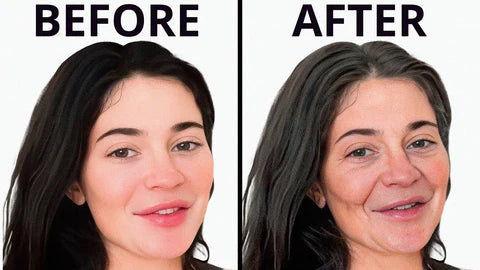TikTok's Viral Aging Filter - Just how accurate are those images?
A few weeks back, filters that could make middle-aged adults look like teenagers were all over the media for… well, not great reasons.
Luckily, another age-related filter has invaded our collective conscience, a filter that ages you.
The now viral TikTok video filter, Aged, has 14 million downloads and it’s been used to make over 11 million videos. What does Aged do? Well, it turns out a lot of things. It adds wrinkles, sagging, volume loss, even jowls to users faces in the pursuit of adding 5 – 20 years.
And to be perfectly honest, it does a pretty good job.
To see my analysis on some of the most popular videos and get my thoughts on how the Aged filter did, click here. But today I thought it would be worthwhile to talk about how faces age to better explain why this filter is so convincing.
There are two forces that mostly drive the aging process: volume loss and gravity.
Volume loss occurs universally as we age, affecting skin, muscle, and bone. Some tissues (skin) deflate, while others (muscle/ligaments/fascia) weaken. Bone loses its density and shrinks, which can make prominent structures, like the jaw and orbital area, look quite different. The sum result of all this is that there just isn’t as much fullness or plumpness to our faces (or anywhere) than we had in our youth.
As tissues weaken, lose volume, and the bone scaffold depletes, over time gravity exerts its effects, leading to jowls, deep wrinkles, and sagging skin – all things we associate with an older face.

There’s a fullness to young faces that volume loss and gravity affect as we get older. Textural changes and wrinkles are another hallmark of the aging process. That doesn’t mean it’s bad, unattractive, or something to be feared.
Of course, there are also skin textural issues that accompany aging, catalyzed by sun damage, collagen loss and pigmentation irregularities. Though skin care and sun protection can help minimize these, volume loss and the effects of gravity are still going to happen.
So, understanding the dynamic forces at work, how accurate and predictive is the Aged filter? Is the image showing you what you’ll really look like in 5, 10, or 20 years?
What the filter does really well
The Aged filter is an algorithm, so it’s taking things we already know happen to aging faces and averages them on a massive scale, and it really does get a lot of the general aging trends right – it decreases volume, hair greyer, adds wrinkles and folds, makes philtrums longer – the list goes on.
Suffice to say the filter did not bring out my best attributes. It deepened my glabellar lines (rhytids), amplified my under-eye hollows (impressive), gave me some great nasolabial folds and marionette lines, lengthened my philtrum, and made my nose more prominent. It even had me briefly considering a fat transfer!
Out of all the regions the filter aged me, it’s really my eyes that stand out.
My best guess? I’m (hoping) this filter put me at about age 55. Fingers crossed I don’t see any of these changes sooner.
And that leads me to my next point.
This filter is convincing, but not predictive
The Aged filter gets a lot of things right. It does a pretty great job aging the midface and it’s uncannily good at aging the eyes. It all works synergistically to make people look more tired and very convincingly older.
That it can show these changes in a dynamic face is even more impressive, though it does seem to falter trying to age faces more than 30+ years.
Is it showing you what you can really expect to look like in 5 to 20 years? Well, that’s where things get tricky. I think it’s more accurate to say you could look like that in 5-10 years. That’s the range the Aged filter really seems to excel. But though it does a great job applying changes to your face that do happen as we generally age, just because it’s convincing doesn’t make it predictive.
What these filters do is age the face in a generic and typical fashion. But those are generalizations. Do they give you a glimpse of what you might look like in the next few decades? Perhaps, but we’re all individuals with different lifestyles and genetics. Perhaps you’ll see some of the features in your future self, but it’s no guarantee – and that goes for the aged features you like, along with the ones you don’t. No filter can quantify your uniqueness. They’re meant for entertainment.
And on the off chance you really don’t like what you see? Though there’s little we can do (short of plastic surgery) to combat gravity, volume loss, and genetics, there’s a lot of other things you can do to age well.
Healthy diet, exercise, and a positive outlook do wonders to improve your health and well-being. Making lifestyle changes that reduce stress and improve your long-term health – like adding sunscreen, quitting smoking, and reducing alcohol consumption – can all have profound effects on how you age.
And remember- aging is a journey – not something to be afraid of! Plenty of people (including some celebrities) are embracing aging and look fantastic into their 40s, 50s, and beyond. You can too.
What about you? Have you played with the popular aging filter? If so, what did you think?

The content of this newsletter is for entertainment and educational purposes only. This content is not meant to provide any medical advice or treat any medical conditions. Patients must be evaluated by an appropriate healthcare provider on an individual basis and treatment must be tailored to meet that patient’s needs. Results and particular outcomes are not guaranteed.





